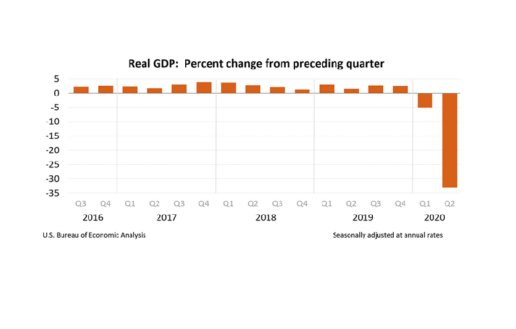
Real gross domestic product (GDP) decreased at an annual rate of 32.9 percent in the second quarter of 2020, according to the “advance” estimate released by the Bureau of Economic Analysis (BEA). In the first quarter, real GDP decreased 5.0 percent.
The decline in second quarter GDP reflected the response to COVID-19, as “stay-at-home” orders issued in March and April were partially lifted in some areas of the country in May and June, and government pandemic assistance payments were distributed to households and businesses. This led to rapid shifts in activity, as businesses and schools continued remote work and consumers and businesses canceled, restricted, or redirected their spending. The full economic effects of the COVID-19 pandemic cannot be quantified in the GDP estimate.
The decrease in real GDP reflected decreases in personal consumption expenditures (PCE), exports, private inventory investment, nonresidential fixed investment, residential fixed investment, and state and local government spending that were partly offset by an increase in federal government spending. Imports, which are a subtraction in the calculation of GDP, decreased.
The decrease in exports primarily reflected a decrease in good, led by capital goods. The decrease in private inventory investment primarily reflected a decrease in retail, led by motor vehicle dealers. The decrease in nonresidential fixed investment primarily reflected a decrease in equipment, led by transportation equipment, while the decrease in residential investment primarily reflected a decrease in new single-family housing.
Other Highlights
- Current‑dollar GDP decreased 34.3 percent, or $2.15 trillion, in the second quarter to a level of $19.41 trillion.
- Current-dollar personal income increased $1.39 trillion in the second quarter, compared with an increase of $193.4 billion in the first quarter. The increase in personal income was more than accounted for by an increase in personal current transfer receipts, notably, government social benefits, that was partly offset by declines in compensation and proprietors’ income.
- Disposable personal income increased $1.53 trillion, or 42.1 percent, in the second quarter. Real disposable personal income increased 44.9 percent.
- While personal income showed overall increases in the second quarter, in June personal income is estimated to have decreased 1.1 percent compared to May, while disposable personal income decreased 1.4 percent and personal consumption expenditures increased 5.6 percent.
A second estimate for the second quarter, based on more complete data, will be released on August 27, 2020. To read the BEA’s full report, click here.
The BEA’s reports are provided as a free service. To subscribe to the service or see other economic and news reports on its website, click here.




